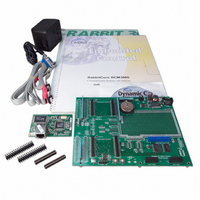101-0523 Rabbit Semiconductor, 101-0523 Datasheet - Page 17

101-0523
Manufacturer Part Number
101-0523
Description
KIT DEV RABBIT3000/RCM3000
Manufacturer
Rabbit Semiconductor
Series
RabbitCore 3000r
Type
MPU Moduler
Datasheet
1.101-0507.pdf
(128 pages)
Specifications of 101-0523
Rohs Status
RoHS non-compliant
Contents
RabbitCore Module, Dev. Board, AC Adapter, Cable and Dynamic C® CD-Rom
Processor To Be Evaluated
RCM3000
Interface Type
RS-232, Ethernet
Maximum Operating Temperature
+ 70 C
Minimum Operating Temperature
- 40 C
Operating Supply Voltage
3.15 V to 3.45 V
For Use With/related Products
RCM3000
Lead Free Status / Rohs Status
Lead free / RoHS Compliant
Other names
316-1017
- Current page: 17 of 128
- Download datasheet (3Mb)
2.3 Run a Sample Program
If you already have Dynamic C installed, you are now ready to test your programming
connections by running a sample program.
If you are using a USB port to connect your computer to the RCM3000 module, choose
Options > Project Options
Communications
Find the file
open it with the
then run it by selecting
play a small square bouncing around in a box.
This program shows that the CPU is working. The sample program described in
Section 6.10, “Run the PINGME.C Sample Program,” tests the TCP/IP portion of the board.
2.3.1 Troubleshooting
If Dynamic C appears to compile the BIOS successfully, but you then receive a communi-
cation error message when you compile and load the sample program, it is possible that
your PC cannot handle the higher program-loading baud rate. Try changing the maximum
download rate to a slower baud rate as follows.
• Locate the Serial Options dialog in the Dynamic C Options > Project Options >
If a program compiles and loads, but then loses target communication before you can
begin debugging, it is possible that your PC cannot handle the default debugging baud
rate. Try lowering the debugging baud rate as follows.
• Locate the Serial Options dialog in the Dynamic C Options > Project Options >
If there are any other problems:
• Check to make sure you are using the PROG connector, not the DIAG connector, on
• Check both ends of the programming cable to ensure that they are firmly plugged into
• Ensure that the RCM3000 module is firmly and correctly installed in its connectors on
• Select a different COM port within Dynamic C. From the Options menu, select
User’s Manual
Communications menu. Select a slower Max download baud rate.
Communications menu. Choose a lower debug baud rate.
the programming cable.
the PC and the programming port on the RCM3000.
the Prototyping Board.
Project Options, then select Communications. Select another COM port from the
list, then click OK. Press <Ctrl-Y> to force Dynamic C to recompile the BIOS. If
Dynamic C still reports it is unable to locate the target system, repeat the above steps until
you locate the active COM port.
PONG.C
File
tab.
menu (if it is not still open), compile it using the
, which is in the Dynamic C
Run
in the
and select “Use USB to Serial Converter” under the
Run
menu. The
SAMPLES
STDIO
window will open and will dis-
folder. To run the program,
Compile
menu, and
9
Related parts for 101-0523
Image
Part Number
Description
Manufacturer
Datasheet
Request
R

Part Number:
Description:
COMPUTER SNGLBD BL2101 A/D 0-10V
Manufacturer:
Rabbit Semiconductor

Part Number:
Description:
CARD D/A 0-10V SR9400 SMARTSTAR
Manufacturer:
Rabbit Semiconductor
Datasheet:

Part Number:
Description:
CARD A/D 0-10V SR9300 SMARTSTAR
Manufacturer:
Rabbit Semiconductor
Datasheet:

Part Number:
Description:
WiFi / 802.11 Modules & Development Tools WIRELESS CONTROL APP KIT
Manufacturer:
Rabbit Semiconductor

Part Number:
Description:
KIT DEV RABBITCORE RCM3750
Manufacturer:
Rabbit Semiconductor
Datasheet:

Part Number:
Description:
KIT DEV RABBIT 2000 INT'L
Manufacturer:
Rabbit Semiconductor
Datasheet:

Part Number:
Description:
KIT DEV RABBIT RCM2000 INT'L
Manufacturer:
Rabbit Semiconductor
Datasheet:

Part Number:
Description:
KIT DEVELOPMENT RCM3700 INT'L
Manufacturer:
Rabbit Semiconductor
Datasheet:

Part Number:
Description:
BL4S200 TOOL KIT
Manufacturer:
Rabbit Semiconductor
Datasheet:

Part Number:
Description:
MODULE RABBITCORE RCM3720
Manufacturer:
Rabbit Semiconductor
Datasheet:

Part Number:
Description:
MODULE RABBITCORE RCM3220
Manufacturer:
Rabbit Semiconductor
Datasheet:

Part Number:
Description:
MODULE RABBITCORE RCM3210
Manufacturer:
Rabbit Semiconductor
Datasheet:

Part Number:
Description:
COMPUTER SGL-BOARD OP6600 W/SRAM
Manufacturer:
Rabbit Semiconductor
Datasheet:

Part Number:
Description:
COMPUTER SGL-BD BL2000 SRAM/FLSH
Manufacturer:
Rabbit Semiconductor










